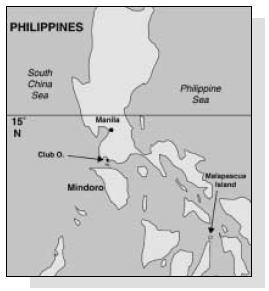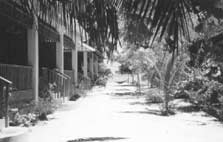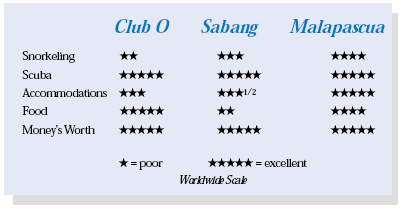Three Stops in the PhilippinesContents of this Issue: Three Stops in the Philippines Hawk’s Nest Resort, Cat Island, Bahamas Divers Stiffed as LCD Leaves Little Cayman Malaria and the Traveling Diver The proof is in — slather on the DEET Editorial Office: Ben Davison Publisher and Editor Undercurrent 3020 Bridgeway, Suite 102 Sausalito, CA 94965 why are Americans missing out? from the September, 2002 issue of Undercurrent
Dear Fellow Diver: Why American divers avoid the Philippines is a mystery to me. The coral reefs surrounding this nation of 7,100 islands are among the most important -- and beautiful -- in the world, providing a habitat for just about the most diverse marine animal species anywhere. Only Sulawesi in Indonesia can compare with the diversity of Southern Luzon and Mindoro. The Philippines is the third largest English speaking country, a plus for us language deficient Americans. Filipinos generally like Americans and our culture -- indeed, most fervently embrace us. It’s an inexpensive country in which to travel. A bottle of excellent San Miguel beer costs $0.60 just about anywhere. Fine resorts are priced well under $100 a night, excellent meals less than $10, and taxis are dirt cheap. Because Filipinos are avid divers, two tank boat dives are set at a level they can afford, often less than $30. And flying to Manila is cheaper than flying to Fiji or even Honduras. In April, my round trip fare on China Airlines from San Francisco to Manila was $599, thanks to Travelocity. Nevertheless, nearly every foreign diver I met in my eight-week sojourn was from Europe. Still, Americans get nervous when they read about Abu Sayyaf and the MILF, and the occasional kidnapings and even beheadings. These rogues kidnapped Americans from Sipadan Island in Malaysia three years ago. However, keep in mind that they operate far south in the Philippines, so unless you visit Mindanao or the southern chain of islands called the Sulu Archipelago (hundreds of miles from the Tubbataha Reef system in the Sulu Sea) you have nothing to worry about. Americans are also mindful that dynamite fishing destroys reefs. Yet I made 150 dives on this trip -- the spoils of retirement -- and saw dynamite destruction but three times. The dive operators will not let destructive fishing damage the reefs they depend upon for business. Diving is usually done from bancas, long, stable boats with outriggers, powered by truck diesel engines. Most are 30 to 40 feet long and 8 feet wide. They usually have canopies over the center so people can stay in the shade and even take naps during a surface interval. The backroll is the way to get into the water, and most bancas have small portable ladders that extend six inches under the surface of the water. Divers normally handed up their gear before climbing aboard. Divemasters are always in the water: the one constant in the Philippines is that divers are never supposed to be out there by themselves. Even if you’re diving the house reef, you still must have a buddy. Dive guides are expected to find rare critters and show them to the divers. To give you an idea of why to consider the Philippines for your next dive destination, let me whet your appetite with a review of the three dive destinations that I visited this year. Club Ocellaris: While people
spend thousands of dollars to get
to Papua New Guinea or the
Indonesia hinterlands for small
critters and muck diving, critter
diving is just about as good here. In fact, I might compare it with “Hairball” in
Lembeh Straits near Manado, Indonesia. Last year, I spent a week at Club O, this
year two weeks, because of a dive site of which I can never tire. I’ve seen professional
photographers dive “Basura” four times a day for a week, refusing to go
elsewhere. Basura is the Spanish word for “garbage,” and a lot of human junk is
scattered here. But there is even more here. Beatrice Reef, located to the east of Sombrero Island, is an irregularly shaped reef with lots of small canyons, swim-throughs, stair steps, and small walls. The reef is lushly covered with soft and hard corals and when there is current, hordes of colorful anthias are dancing just above the reef. The sheer numbers and kinds of nudibranches here are amazing. One thing to note: there are not many large fish here. Club O, a basic dive resort on Balayan Bay in the province of Batangas, is 2.5 kilometers by car to the south of the Manila airport. The owner, Boy Venus (yes, that’s his real name), will arrange an airport pickup and drive for $50. Boy, a good-natured, enthusiastic diver, created Club O as a vacation spot for himself and his friends, who come to the resort on weekends and dive with their own divemasters. Club O is at the foot of a forested cliff, overlooking the ocean, about 100 feet below the main road. The top floor consists of five large rooms, each with two pairs of bunk beds and a bathroom. They don’t have AC, but large floor fans kept me comfortable at night. There is a large veranda with couches and chairs and tables where I worked on my camera. Boy will try to put you and your buddy (if you have one) in a room by yourselves. One weekend I shared a room with Boy and his girlfriend; they slept on the veranda, leaving me the room to myself. Weekend guests usually bed down outside on the decks. Down one floor is the dining room, open on two sides and used mostly during rainy weather. Another flight down is the open terrace, where they serve meals al fresco next to the sea. They keep an ice chest filled with soft drinks and beer. The dive gear area is a short distance away, where there are an outdoor shower and large water tanks for rinsing gear. A final set of steps takes you to the beach and the bancas. There is no beach diving.
Boat rides to the sites ranged from five minutes to an hour. The schedule is to have two morning boat dives, one afternoon boat dive, and a night boat dive (even if only one diver wants to go). At shallow critter sites, 90 to 120-minute dives were common. Photographers and sightseers take separate bancas and never visit same site. Club O folks have a great understanding of what underwater photographers want. Unlimited bottom time? No problem. Go back to the boat to change film in the middle of a dive, then go back down again? Go for it. You decide when and where to dive and when to eat. My buddy and I agreed that night dives at 10:00 P.M. were preferable, so we asked to eat dinner at 7:00 P.M. but have our soup and dessert at 11:30 P.M. when we got back. No problem. My buddy fell in love with the mangoes and asked for them every morning for breakfast and every evening for dessert. Nothing else. No problem. The price for all this? $120 a day, which is on the high side for the Philippines. Yet that includes the four boat dives, room, buffet meals, and all the mangoes you can eat. Sabang Inn. For $2 it’s a 2-hour trip on a Sabang Princess banca from Batangas, then a twominute walk to the Sabang Inn. Sabang is a small beach town, packed with apartments, condos, small hotels, dive shops, restaurants, bars, discos, and lots of young people. Few dive destinations can compete with Sabang for allnight action. Everything is compactly located, so it is only a few minutes’ walk to any night spot. The 16-room Sabang Inn has basic rooms for $18. Add $3 for hot water and another $3 for an ocean view. Rooms include a kitchenette, AC, and cable TV (65 channels). A small pool next to the dive gear area is good for rinsing the salt off your skin. The Sabang Inn offers breakfast and lunch, and a host of decent restaurants are nearby. I made 21 dives during the week and, all told, spent about $500. Compared with the Club O, reefs here are prettier, with more schools of larger fish, such as sweetlips and snappers. Large groupers are uncommon, though I did see several large potato cod at Hole in the Wall. Sites like Fishbowl are 130 to 165 feet deep and require decompression. At Drydock, currents are strong. I needed my reef hook to shoot the huge mangrove jacks that hung out inside the drydock. The variety of exotic critters around the Sabang Wrecks is similar to Basura, but most divemasters lack the training to find them regularly. Three wooden wrecks in the Sabang harbor are habitat for ghost pipefish and frogfish. On the bottom (20 to 65 feet), a sharp-eyed diver can spot all kinds of strange animals. I saw a blue-ringed octopus -- its bite will kill you -- the blue-fin lionfish (supposedly endemic to north Bali) and pygmy seahorses. It’s an excellent night dive. With the lights from Sabang, it’s hard to get lost and one could swim to shore in a pinch. The Canyons, one of the fishiest sites in the Philippines, is the signature
dive site at Sabang. Depending on the current, the direction of the dive, and which
of the three canyons you dive, will vary, creating a feeling of newness even after
diving the site several times. Dive operators mix divers of all skills and limit the length of dives. Still, I could get 70 minutes on dives to normal depths. Three boat dives a day run $39. And they have Nitrox. Sabang Divers uses planing skiffs with large outboards that get to most sites in five minutes and return you to the resort after each dive. If you have a buddy, you can dive the house reef anytime, with no extra charge for tanks. Sabang tries to follow PADI rules, but they are relaxed about diving beyond 130 feet and developing a decompression ceiling. Several Sabang dive operators are heavily into technical diving. One Action Diver instructor apparently holds the world’s open water depth record of more than 1000 feet. The dive only took nine and a half hours. Malapascua Island Exotic Dive Resort: I returned to Manila and flew round trip to Cebu City for $100. Cebu Pacific does not charge for luggage weighing more than 20 kgs if you show them a C-card. For $35, I hired a car and driver for the fourhour drive north to Maya at the north tip of Cebu, then spent $10 to hire a boat for the half-hour ride to Malapascua Island. Unlike my previous two destinations, this felt like a luxury resort. Four new buildings sit along on a pretty, sandy beach with many palm trees, lots of hammocks and chaises, a bar, and a full restaurant. Rooms with AC, a large bathroom, comfortable beds, and a lanai overlooking the beach are less than $25. At happy hour, you can get two shots of tequila for the price of one: $1.40. Good dinners run $4 to $6. The club sandwich at $2.20 consisted of tuna, egg, ham, cheese, and veggies between five slices of bread. Chilled bottled water ran $0.50. Two divemasters are Dutch and one is Filipino. The signature dive leaves at 6:00 A.M. for Monad Shoal, a thresher shark cleaning station at 80 feet. I did the dive six times and saw four thresher sharks on five dives. Twice I had a 15-foot thresher shark come close enough to use my 28mm Nikonos lens. I also found magnificent mandarin fish here. Like all mandarin fish, they never come out unless they sense that I am out of film or my strobe has powered down. They have Nitrox, and for this and other dives, provide half a dozen tanks with mixes between 34.9 and 37.1. The first diver there gets his pick. The best diving is the marine preserve at Gato Island, a two-dive trip with a 45-60-minute boat ride. The island, itself, is honeycombed with tunnels and swimthroughs. All have vertical routes to the surface and most are light enough to be safe to enter during the day. Exploring them is great fun. Some undercuts hold good-sized white tip sharks, napping away the day before their evening hunt. But some white tips are also active, and to entertain you there are Pegasus seamoths, ornate and robust ghost pipefish, yellow pygmy seahorses, lots of smooth and thorny seahorses, large Spanish dancers, and other nudibranchs. Schools of large mouth mackerel, many vermiculated angelfish, a few dogtooth tuna, and even a small whale shark made this diving very special. They run an all-day (leave at 5:00 A.M., return at 6:00 P.M.) exploratory dive safari to Maripipi Island and other islands. They have a wreck dive on the Dona Marilyn, a ferry that went down in 1984 with the loss of 2,000 souls, a dive on a Japanese WWII wreck, and many pretty soft coral sites. Dives are $20 and for a buck more you can get 35 percent to 37 percent Nitrox, to extend your 75-foot dive from 40 minutes to 80. So, if you’re a fish photographer, put the Philippines high on your list. March through May is normally the warmest time of the year because it has the least rain. The water is 78 to 79F in March, warming to 82 to 84F in May during a normal year. June brings monsoon season. Diving is still OK, but heavy rains can reduce the visibility and ambient light. From July through October there is a significant risk of typhoons (hurricanes) anywhere north of about 11 degrees latitude. -- T.A. |

I want to get all the stories! Tell me how I can become an Undercurrent Online Member and get online access to all the articles of Undercurrent as well as thousands of first hand reports on dive operations world-wide
| Home | Online Members Area | My Account |
Login
|
Join
|
| Travel Index |
Dive Resort & Liveaboard Reviews
|
Featured Reports
|
Recent
Issues
|
Back Issues
|
|
Dive Gear
Index
|
Health/Safety Index
|
Environment & Misc.
Index
|
Seasonal Planner
|
Blogs
|
Free Articles
|
Book Picks
|
News
|
|
Special Offers
|
RSS
|
FAQ
|
About Us
|
Contact Us
|
Links
|
3020 Bridgeway, Ste 102, Sausalito, Ca 94965
All rights reserved.

 The trash makes a wonderful habitat for all kinds of cryptic and
rare critters. It was not uncommon to hear “I found the ghost pipefish right next
to the cutoff blue jeans.” The best stuff is between 6 and 50 feet and some as
deep as 100 feet. At night, it seems like many critters that live deeper come crawling up or swimming close to the beach.
Thanks to guides like Homer and Perry, I can
count on seeing every species and color of
ghost pipefish and frogfish, the flamboyant
cuttlefish, the rare seamoth, and the beautiful
searobin. Here I saw wonderpus, the
extraordinary mimic octopi, spooky bobbit
worms, Ambon scorpionfish, crocodile snake
eels, and photogenic harlequin shrimp dining
on a blue seastar. And this has to be the
nudibranch capital of the world, not to mention
the really strange critters like melibes
and pleurobranchs that live here. All divemasters
pride themselves on being able to find
rare animals. Basura may not be pretty, but
it is one of the best critter sites in the
world.
The trash makes a wonderful habitat for all kinds of cryptic and
rare critters. It was not uncommon to hear “I found the ghost pipefish right next
to the cutoff blue jeans.” The best stuff is between 6 and 50 feet and some as
deep as 100 feet. At night, it seems like many critters that live deeper come crawling up or swimming close to the beach.
Thanks to guides like Homer and Perry, I can
count on seeing every species and color of
ghost pipefish and frogfish, the flamboyant
cuttlefish, the rare seamoth, and the beautiful
searobin. Here I saw wonderpus, the
extraordinary mimic octopi, spooky bobbit
worms, Ambon scorpionfish, crocodile snake
eels, and photogenic harlequin shrimp dining
on a blue seastar. And this has to be the
nudibranch capital of the world, not to mention
the really strange critters like melibes
and pleurobranchs that live here. All divemasters
pride themselves on being able to find
rare animals. Basura may not be pretty, but
it is one of the best critter sites in the
world.
 Each canyon has its own resident fish: ribbon sweetlips, paddletail snappers,
harlequin sweetlips,
oriental sweetlips,
and a variety of other
snappers and sweetlips
tend to school in the
same areas.
Each canyon has its own resident fish: ribbon sweetlips, paddletail snappers,
harlequin sweetlips,
oriental sweetlips,
and a variety of other
snappers and sweetlips
tend to school in the
same areas. Diver’s Compass: All the operators have you sign a waiver and provide
your C-card number and level of certification; overall, the
“big brother quotient” is very low. Everywhere aluminum 80s are
the norm, always filled to 3000 psi. All boats have cell phones to
call for help. There are chambers at Anilao and Sabang. Most
places cook American breakfasts, with eggs, bacon, and orange juice
for $2.50. Lunch and dinner are often buffet style with barbequed
chicken, pork, steamed fish, curries, steamed rice, shrimp, or lobster. Filipinos
are very aware of American eating habits. After all, they have Denny’s, McDonald’s,
Burger King, etc., in all the larger cities. Most traveling divers are either
Europeans who mostly don’t tip or Asians who tip little. Even Aussies and Kiwis
rarely tip. I always tip my Club O dive guide and it is very much appreciated.
Club Ocellaris: e-mail: Boy Venus
Diver’s Compass: All the operators have you sign a waiver and provide
your C-card number and level of certification; overall, the
“big brother quotient” is very low. Everywhere aluminum 80s are
the norm, always filled to 3000 psi. All boats have cell phones to
call for help. There are chambers at Anilao and Sabang. Most
places cook American breakfasts, with eggs, bacon, and orange juice
for $2.50. Lunch and dinner are often buffet style with barbequed
chicken, pork, steamed fish, curries, steamed rice, shrimp, or lobster. Filipinos
are very aware of American eating habits. After all, they have Denny’s, McDonald’s,
Burger King, etc., in all the larger cities. Most traveling divers are either
Europeans who mostly don’t tip or Asians who tip little. Even Aussies and Kiwis
rarely tip. I always tip my Club O dive guide and it is very much appreciated.
Club Ocellaris: e-mail: Boy Venus 